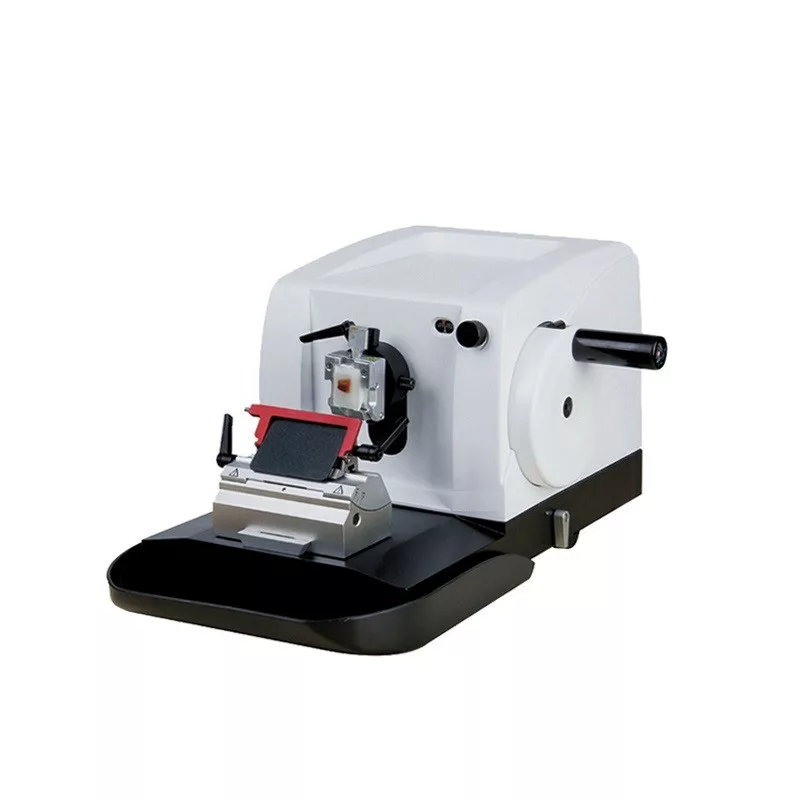Manual Rotary Microtome: Precision Cutting for Histology and Pathology
A Manual Rotary Microtome KRM/M/60 is an essential instrument in histology, pathology, and research laboratories, enabling the precise sectioning of biological samples for microscopic analysis. With its manual operation, the rotary microtome is widely regarded for its accuracy, control, and reliability. Whether you’re preparing tissue samples for disease diagnosis or conducting research, a manual rotary microtome provides the precision needed for thin, uniform slices of tissue or other materials.
What is a Manual Rotary Microtome?
A Manual Rotary Microtome is a mechanical device designed to cut extremely thin sections of biological samples, typically tissues, for examination under a microscope. This instrument uses a sharp blade and a rotating handwheel to manually control the movement of the sample block, ensuring consistent, repeatable cuts. The thickness of each section can be finely adjusted, making it ideal for routine histological studies, research, and educational purposes.
How Does a Manual Rotary Microtome Work?
The operation of a Manual Rotary Microtome involves several key components:
- Sample Block: The tissue sample is embedded in a paraffin block and mounted onto a specimen holder.
- Blade: A microtome blade or knife is positioned at an adjustable angle for precise cutting.
- Rotary Handwheel: The handwheel controls the movement of the specimen toward the blade in a smooth and controlled motion.
- Section Thickness Control: Operators can adjust the section thickness, typically ranging from 1 to 100 micrometers, depending on the application.
- Specimen Advancing Mechanism: Each rotation of the handwheel advances the specimen toward the blade, cutting a thin section ready for microscopic analysis.
This simple, manual operation provides full control over the sectioning process, making it a preferred tool for routine tissue preparation in labs worldwide.
Key Features of a Manual Rotary Microtome
When selecting a Manual Rotary Microtome, it’s essential to consider the following features to ensure precision, ease of use, and durability:
- Precision Cutting: High-quality manual rotary microtomes provide fine adjustments to section thickness, ensuring uniform slices of tissues for accurate analysis.
- Durable Construction: Designed with robust materials for long-lasting use in busy laboratory environments.
- Ergonomic Design: Features like a comfortable handwheel, easy blade insertion, and a specimen holder ensure user comfort and reduce strain during prolonged use.
- Specimen Stability: Secure clamping mechanisms ensure that the sample block remains steady, reducing vibration and ensuring precise sectioning.
- Low Maintenance: With minimal mechanical complexity, manual rotary microtomes require less maintenance compared to their automated counterparts.
- Safety Features: Look for models that include safety locks and protective covers to minimize the risk of accidental cuts.
Applications of Manual Rotary Microtomes
Manual Rotary Microtomes are widely used across various sectors, including:
- Histology: For preparing thin sections of tissue samples, which are later stained and examined under a microscope for diagnostic purposes.
- Pathology: In hospitals and research labs, manual rotary microtomes help prepare samples for detecting diseases such as cancer and other tissue abnormalities.
- Biological Research: Researchers use microtomes to prepare samples for studying the microscopic structure of tissues, cells, and other biological materials.
- Pharmaceuticals: Pharmaceutical companies utilize microtomes for quality control and research involving tissue samples and drug development.
- Educational Purposes: Used in educational institutions to train students in sample preparation and microscopic analysis techniques.
Benefits of Using a Manual Rotary Microtome
- Enhanced Precision: Manual control allows operators to achieve consistent, precise slices, which is critical for accurate analysis.
- Cost-Effective: Manual rotary microtomes are typically more affordable than automated models, making them ideal for smaller labs with tighter budgets.
- User Control: Full manual operation ensures that the operator maintains complete control over the sectioning process, enhancing accuracy in applications that demand precision.
- Reliable and Durable: Built for long-term use in demanding environments, these microtomes are known for their robustness and reliability.
- Versatility: Suitable for a wide range of tissue types, making it a versatile tool for many laboratory applications.
Choosing the Right Manual Rotary Microtome
When selecting a Manual Rotary Microtome, it’s important to evaluate your laboratory’s specific needs. Consider the types of samples you will be working with, desired section thickness, frequency of use, and any ergonomic or safety features that can enhance user experience. Investing in a high-quality microtome will ensure reliable performance and accurate results for years to come.
Conclusion
A Manual Rotary Microtome is an indispensable tool for any laboratory involved in tissue sectioning for histology, pathology, or biological research. With its precise manual operation, it provides the accuracy and control needed to prepare samples for microscopic examination, ensuring high-quality results. For labs seeking a cost-effective, reliable, and easy-to-use solution, a manual rotary microtome is an excellent choice.





Reviews
There are no reviews yet.